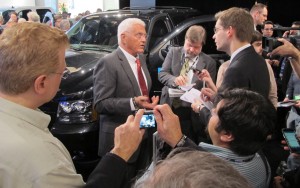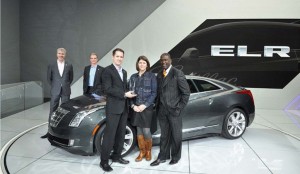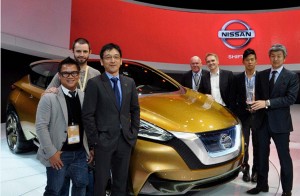According to the latest consumer surveys, good fuel economy is the number one factor for potential car buyers. But put two vehicles with similar mileage together and you can be all but certain most customers will opt for the more stylish model.
No wonder good design plays such a significant role in drawing the public to an auto show like the North American International Auto Show, or NAIAS, in Detroit. And a group of professional stylists have weighed in on which of the nearly 60 cars, trucks, crossovers and concepts had the most visual appeal.
The 2014 Cadillac ELR, the luxury maker’s new plug-in hybrid, got the nod winning the EyesOn Design Award for Best Production Vehicle. And in a first-ever tie, the Ford Atlas and Nissan Resonance shared honors with the EyesOn Design Award for Best Concept Vehicle.

Bob Lutz, shown here speaking to reporters at the Detroit Auto Show, was honored for a career strongly supporting good design.
Meanwhile, former General Motors car czar Bob Lutz, who remains active in the business despite turning 80 last year, was the inaugural winner of the Catalyst Award, meant to honor an executive who has championed design during their career. “Some people change the paradigm and break the rules,” said his citation.
“Today the worst car in the quality survey would’ve won five years ago,” Lutz himself said as he accepted the honor. “What is left is design. It is a perfectly rational thing for customer to base his or her choice on design.”
One of the many products Lutz championed before leaving GM several years ago was the Chevrolet Volt, the first mainstream plug-in hybrid-electric vehicle. Though it fell well short of the maker’s aggressive target for 2012, Volt nonetheless tripled sales. Now, GM is hoping to expand its appeal by targeting an upscale niche that may be less bothered by the premium for battery power.
The ELR joins several other new luxury models using electric drivelines, including the Fisker Karma plug-in and Tesla Model S battery-electric vehicle. Its edgy design picks up on the distinctive Art & Science design theme used for other Cadillac models, such as the ATS sedan that was also honored as North American Car of the Year in a separate event this week.
“This is a pivotal moment in Cadillac’s history, as we continue our product-driven expansion,” said Bob Ferguson, Cadillac’s global marketing chief, as the maker prepares to come to market with the luxury version of the Chevrolet Volt plug-in.
(For a closer look at Cadillac’s luxury extended-range electric vehicle, Click Here.)
Concept cars have, meanwhile, always been a big draw at auto shows, and this year’s North American International Auto Show was no exception. Dubbed “fantasies in chrome” by EyesOn judge and former Ford Design Director Jack Telnack, they’ve traditionally been wild fantasies.
But in recent years, concept vehicles have had at least some grounding in reality. The Acura MDX Concept, for example, is a thinly disguised version of the production model that will reach showrooms for the 2014 model-year.
That said, there were a number of show cars at the 2013 Detroit Auto Show pushing the design envelope, such as the controversial Hyundai HCD-14 Genesis, the first of the maker’s concept vehicles developed by new advanced design director Chris Chapman.
(For more on the Hyundai HCD-14, Click Here.)
The HCD-14, which Chapman has suggested offers “a hint” of where the next Hyundai Genesis will go, narrowly lost to the Ford Atlas Concept and the Nissan Resonance in the concept category.
The first-ever winners of a tie, both also are meant to provide a clear sense of where their makers are going, though Ford and Nissan officials caution that they are less literal interpretations of the production cars to follow than the Acura MDX Concept.
Nonetheless, both of the winning show cars generated a fair bit of attention at the NAIAS. And for good reasons.
The unveiling of the Atlas was kept a secret by Ford until the last minute and drew attention away from its two key competitors — the Ram 1500 full-size pickup having earlier taken North American Truck of the Year honors and Chevrolet unveiling the new Silverado pickup at the Detroit show.
(Click Here for a look at the Ford Atlas Concept.)
The Resonance, meanwhile, reveals the broad design direction of the next Nissan Murano. The original version of that crossover was among the very first CUVs to break away from traditional, truck-based sport-utility styling and introduce a distinctive look of its own.
(For more on the Nissan Resonance, Click Here.)



